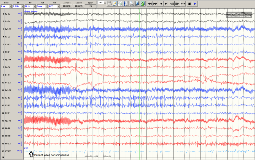Use of Combined Electroencephalography and Tilt Table Testing to Determine Etiology of Loss of Consciousness
Abstract number :
2.032
Submission category :
3. Neurophysiology / 3C. Other Clinical EEG
Year :
2018
Submission ID :
501059
Source :
www.aesnet.org
Presentation date :
12/2/2018 4:04:48 PM
Published date :
Nov 5, 2018, 18:00 PM
Authors :
Neeraj Singh, Albany Medical Center and Anthony L. Ritaccio, Albany Medical College
Rationale: To describe a diagnostic protocol that can differentiate epileptic seizures from syncope and nonphysiologic events by combining electroencephalography (EEG) with tilt table testing. Methods: A protocol was developed at our institution to record EEG while conducting a tilt table test to simultaneously evaluate for EEG correlates secondary to cardiovascular changes in patients being evaluated for repetitive episodes of loss of consciousness potentially consistent with syncope. The protocol was generated not only to document established EEG accompaniments (generalized slowing evolving into absence of recordable EEG signal) associated with cardiac and clinical manifestations of syncope, but to potentially confirm persistence of a normal waking EEG associated with nonphysiologic events, such as psychogenic nonepileptic seizures or psychogenic pseudosyncope. In this protocol, EEG leads are applied before the patient is placed supine on a motorized table to monitor baseline vital signs. Baseline EEG recording begins prior to the table turning vertically to an angle of 60-70 degrees. Vital signs are monitored regularly as the patient is evaluated for a clinically observable event for at least 20 minutes. If there is no event, a vasoactive medication, such as isoproterenol or nitroglycerin, is administered, and the patient is monitored for an event for at least 20 minutes more. The EEG recording ends at the end of the tilt table study. Results: Over six years, 50 EEG studies were combined with tilt table studies. Out of these, 32 (64%) studies showed preserved awake EEG features, normal EKG rhythms, and absence of clinical events. Out of the remaining 18 (36%) studies, 6 captured clinical syncope with expected EKG and EEG pathologic accompaniments, while 7 studies recorded preserved normal EEG and EKG in the setting of behavioral unresponsiveness, diagnostic of pseudosyncope, as seen in the figure. Conclusions: While the majority of the combined EEG and tilt table tests did not capture events, EEG abnormalities, or cardiovascular changes, the remaining studies were critical in distinguishing patients with pseudosyncope from those with true syncope. This protocol should be considered for more widespread use for patients with a broad differential diagnosis for loss of consciousness. Funding: Not applicable
